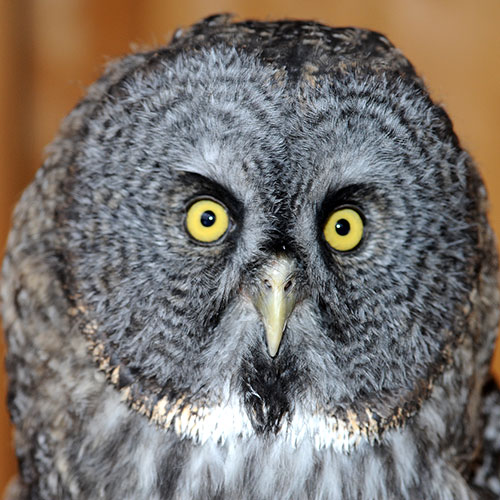Gus’s Story
Gus is a great gray owl (Strix nebulosa) who came to the WSU Veterinary Teaching Hospital in September of 2009. He was found on a driveway in someone’s yard near Spokane, unable to fly due to a fractured right wing. When he arrived at the vet hospital, the attending veterinarian determined that the wing was so badly fractured that it could not be saved. The veterinarian made the decision to amputate his wing at the elbow. This proved very fortunate for Gus, since amputations above the elbow tend to cause major difficulties for captive birds; without extenuating circumstances, euthanasia is mandated by law for such birds, in the interest of their own welfare. Gus’s amputation was just below this threshold, allowing him to remain healthy in captivity. Since he can no longer fly, Gus will spend the remainder of his life in captivity.
Facts about the Great Gray Owl
Habitat:
Hunting & Diet:
Great gray owls are usually crepuscular, hunting mostly at dawn and dusk, but are capable of hunting any time during the day or night, an adaptation due in part to the prolonged day and night periods typical of far northern latitudes. Their primary source of food is small mammals such as voles and lemmings, but they will also eat insects, amphibians, and birds. They tend to choose a perch beside a meadow or along the edge of the forest, flying out from that perch to hunt. Great grays have much smaller feet than other large owls, which are perfectly adapted to the small mammals that they eat, but their small size prevents these owls from hunting the larger prey that great horned owls are known to catch. Their extraordinary hearing allows them to hunt prey that is tunneling under the snow.
Like other owl species that depend primarily upon hearing to hunt, great gray owls can pinpoint the exact location of their prey by triangulating the location of the sound it makes. They then swoop down and dive feet-first into the snow, often emerging with a meal in their grasp. By clenching their feet, great grays can break through the snow to reach prey over a foot below the surface. One record-setting great gray owl broke through ice layers on top of packed snow that would normally support a person weighing 175 pounds.
Mating & Nests:
Great gray owls will use empty nests built by other birds. They will also nest in broken-off tree stumps, platforms, and sometimes on the ground. The owlets (chicks) will leave the nest before being able to fly, a strategy that avoids attracting predators to the smell of accumulated owl droppings around the nest. Due to the owlets remaining on the ground after leaving the nest, when the chicks are “fledging” (learning to fly), they will run up logs or leaning trees and jump off the ends to achieve lift while practicing.
Identifying Characteristics:
Their scientific name comes from the Latin word “nebulosa,” meaning “clouded,” and refers to their gray and white plumage coloring. Great gray owls are the largest owls in North America in terms of height, standing about 2-3 feet tall. However, both the great horned and snowy owls tend to outweigh the great gray. Most of the great gray’s size is attributed to dense feathering, resulting in a typical weight range of only 1 ½ to 3 pounds. The snowy owl also has a greater wingspan, reaching up to 5 ½ feet, while the great gray owl has a wingspan of 4 ½ to 5 feet.
Great gray owls can make a variety of noises when communicating. Their standard call is a series of very deep rhythmic “hoots”. When threatened, they can click their beak and hiss. They can also make a high pitched squeaking noise.


